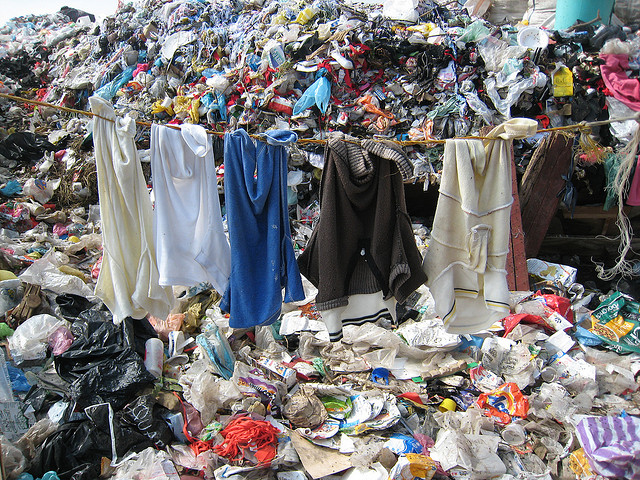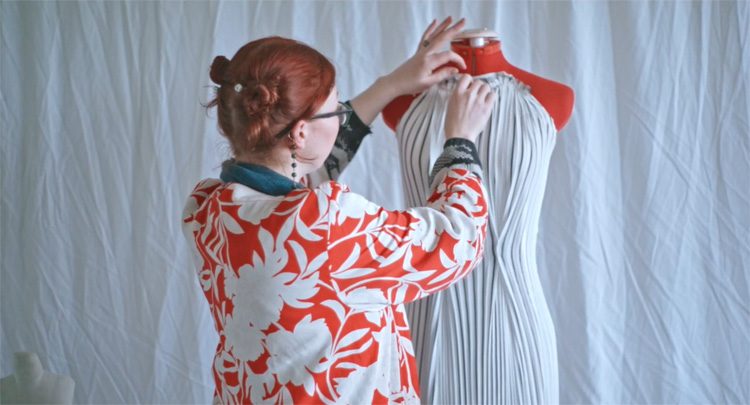Everything Wrong With Our Pants
Last week, as I ambled along on my morning walk, I noticed a pair of jeans crumpled against a storm drain. The pants got me thinking about how long they would be there, what poor person constructed them, and the journey they made from cotton to Levis only to be left on the curb. According to an article by Sabine Weber, “the average time consumers keep a garment is just three and a half years” (para. 3) and a consumer in the US creates “30 to 40 kilograms of textile waste” annually (Weber para. 3).
Garments made of purely cotton and denim are more biodegradable than other materials on the market. The jeans I found can take up to a year to biodegrade if they are purely denim (Drosdick para. 6) but will remain much longer if the material is mixed. In comparison, cotton decomposes in “one week to five months” (Assoune para. 8)
While both of these fabrics might compost eventually, they require a hefty amount of pesticides and water in their making. Clothing produced out of a mixture of Nylon, Polyester, and Spandex can take decades to centuries to decompose (Drosdick para.6) and the majority of pieces employ harmful dyes. Dyes can make their way into the environment and our skin (Luongo et al. 2755).

The Solution
So what do we do? We need to address two things. The first is that the majority of fabrics we use pollute the earth and the process by which they are made is unsustainable. Secondly, consumers are detached from the life of their clothing and are unaware of the process to make it.
In Luz Claudio’s book Waste Couture : Environmental Impact of the Clothing Industry, Claudio comments that prior to the 1920s most clothing was “repaired, mended, or tailored to fit other family members or recycled within the home as rags or quilts. During the war, clothing manufacturers reduced the varieties, sizes, and colors of their productions and even urged designers to create styles that would use less fabric and avoid unnecessary decoration” (451). People valued fabric and favoured longevity.
So how can we recreate this sustainable attitude and what material can we used that has low environmental impact? Amanda Morglund’s answer is mushrooms. Morglund is a fashion designer and Director of Fungi solutions, an organization that uses fungi to turn waste into new materials.

Fungi as Fashion
“The application [mycelium] is most suited to is as a replacement for animal leathers, suedes, velvet, single use plastic packaging, styrofoam and polyurethane foams. I see the clothing, accessories, jewellery and packaging all being available in mushroom based materials very soon,” Morglund said in an email.
Put simply, Morglund “takes a tiny piece of a mushroom’s root system, called mycelium, adds it to her textile” and when “the surface has been completely taken over, mushrooms start to sprout. Then these sprouts are removed, the textile is dried out, and she’s left with a sheet of mushroom roots that mimics regular fabric” (Kerr-Crowley para. 9). Mushrooms have low water and energy input in the cultivation process and are completely biodegradable. Morglund explained that they have “high durability, good flex and can last 20+ years if cared for. Different material properties (like leather hide or like suede) can be created by adjusting the cultivation conditions (light, humidity, nutrition and oxygen)”. While mycelium may be a sustainable material to add to the world of fast fashion, Morglund calls for a new model of consumption.
“There is a need for sustainable production and purchasing practices,” Morglund said. “Connecting people to their garments, how they were made and how they can be maintained or reused does seem to have an impact on how long those clothes are kept and how much wear they see, which is great for the planet. I think technology could have a great role in combination with innovative sustainable materials in changing the fast fashion model to something else”.
While the fashion and consumer industry may need to undergo bigger changes than an introduction of sustainable materials, there are several promising resources besides mushrooms. Morglund believes that algae and plant cased leathers like pineapple and cactus can contribute to the progress of sustainable fashion.
A company called Vollebak offers a garment they call the “Plant and Algae t-shirt”. Vollebak uses the algae for dye while the fabric is made from the wood pulp of Eucalyptus and Beech. The shirt can be composted and can take as fast as eight weeks to biodegrade. The company Hugo Boss crafted a shoe with “minimal imprint on the planet” by using pineapple leaf fibres for leather while another company called Off Set Warehouse creates a fabric out of banana and pineapple that mimics silk.

What You Can Do Now
Although these products are available to order, they are not as accessible as the clothing we pick off the racks in our local stores. If you are wondering how you can contribute to sustainable fashion with the clothes you own now, consider growing mushrooms on your natural fibre clothes that are too worn to reuse.
“I always encourage everyone to grow a quick crop of mushrooms on their natural fibre garments that are too damaged for donation,” Morglund said. “And simply compost them as soil conditioner rather than throwing them in the landfill.” Morglund currently hosts workshops that explore recycling at home with fungi to produce things like paper and planters. Her organization’s goal is to “[demystify] mushrooms and make cultivation as accessible and normal as recycling”.
To learn more on Amanda Morglund’s projects, visit https://gardenstates.entheogenesis.org/fungalconservation-and-democratising-science/.

Sustainable, Alternative Fashion available for purchase
- The Plant and Algae t-shirt: https://www.vollebak.com/product/plant-and-algae-t-shirt/
- Bed Threads 100% French Flax Sleepwear: https://bedthreads.com/collections/sleepwear
- Pinatex Shoes by Hugo Boss: https://www.hugoboss.com/uk/men-vegan-shoes/
- Hemp Clothing Australia is Biodegradable: https://www.hempclothingaustralia.com/
- Desserto’s Cactus Vegan Leather: https://mymodernmet.com/vegan-cactus-leather-desserto/
- Offset Warehouse’s Pineapple and Banana Silks: https://www.offsetwarehouse.com/collections/pineapple-and-banana
Works Cited
Weber, Sabine. “The Afterlife of Clothes.” Alternatives Journal (Waterloo), vol. 41, no.
3, 2015, pp.26-29.
Assoune, Alex. “The Time It Takes Clothes to Decompose in Landfills.” Panaprium, n.d.
https://www.panaprium.com/blogs/i/clothes-decompose-landfill
Drosdick, Dana. “How Long It Will Take Your Clothes to Decompose, By Fabric.”
Peaceful Dumpling, An Elite CafeMedia Lifestyle Publisher, December 28th, 2020, https://www.peacefuldumpling.com/clothing-decompose-rate
Claudio, Luz. “Waste Couture: Environmental Impact of the Clothing Industry.”
Environmental Health Perspectives, vol. 115, no. 9, 2007, pp. A448–A454. JSTOR, www.jstor.org/stable/4626880. Accessed 23 Apr. 2021.
Luongo, G., Thorsén, G. & Östman, C. “Quinolines in clothing textiles—a source of
human exposure and wastewater pollution?” Anal Bioanal Chem 406, 2747–2756 (2014). https://doi-org.ezproxy.viu.ca/10.1007/s00216-014-7688-9
Kerr-Crowley, Maeve. “Fungi Fashion.” Fashion Journal, October 21st, 2019,
https://fashionjournal.com.au/fashion/making-clothes-mushroom-fabric/
